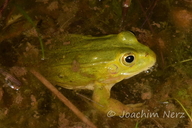|
Pelophylax lessonae (Camerano, 1882)
Pool Frog | family: Ranidae genus: Pelophylax |
 © 2016 Dr. Joachim Nerz (1 of 47) |
|
|
|
Description Distribution and Habitat Country distribution from AmphibiaWeb's database: Austria, Belarus, Belgium, Bosnia and Herzegovina, Croatia, Czech Republic, Denmark, Estonia, France, Germany, Hungary, Italy, Kazakhstan, Latvia, Liechtenstein, Lithuania, Luxembourg, Moldova, Republic of, Montenegro, Netherlands, Norway, Poland, Romania, Russian Federation, Serbia, Slovakia, Slovenia, Sweden, Switzerland, Ukraine. Introduced: Spain, United Kingdom.
Pelophylax lessonae inhabits deciduous and mixed forests. The frog penetrates steppe within forests and bushlands (e.g. riparian alder groves). It occurs primarily in stagnant water bodies such as lakes, ponds, swamps, large puddles and ditches, generally covered with dense herbaceous vegetation. The pools may be located within the forests, in glades and forest edges, in fields and flooded meadows. The frog occasionally stays in shallow pools along small rivers and streams. The presence of permanent water is necessary for the existence of P. lessonae populations. In the forest zone, when the air humidity is high, the frog frequently occurs on land far away from water bodies. Using chains of small ponds, the frog can migrate distances of up to 8 km. Life History, Abundance, Activity, and Special Behaviors Tadpoles consume primarily algae: Cyanophyta, Chlorophyta etc. Juveniles eat large amounts of flies and fly larvae. They sometimes climb plant leaves (at a height up to 0.5 m) to forage. The food of adults consists mainly of terrestrial invertebrates (mainly insects). Aquatic organisms (Gerridae, Dytiscidae etc.) comprise usually less than a half of prey items. Feeding does not cease during the breeding season. The Pool Frog is not as voracious as the taxonomically and ecologically similar Marsh Frog (P. ridibunda), evidently due to its smaller body size. However, different amphibians and even juvenile grass snakes are consumed time by time. Trends and Threats Pelophylax lessonae went extinct in england in the mid 1990's. Reintroduction attempts using populations from Norway and Sweden (started in 2005) appear to have been successful (John W. Wilkinson & John Buckley, FrogLog 2012). Relation to Humans Possible reasons for amphibian decline General habitat alteration and loss Comments In 2016 Orizaola and Laurila found that three populations of P. lessonae from the northernmost populations, isolated in the Uppland district north of Stockholm, Sweden, display greater thermal phenotypic plasticity than three populations from Poland (about the center of the species distribution) and Latvia (two from northern-edge populations). The Uppland populations show greater temperature-induced plasticity affecting duration of the larval period, mass at metamorphosis, and growth rate, than other populations. All these variables are important in facilitating positive responses to periodic warm spells in colder environments with shorter growing seasons. Geographic variation in plasticity of life history components should be considered in predicting responses of particular species to climate change.
References
Bannikov, A. G., Darevsky, I. S. and Rustamov, A. K. (1971). Zemnovodnye i Presmykayushchienya SSSR [Amphibians and Reptiles of the USSR]. Izdatelistvo Misl, Moscow. Bannikov, A. G., Darevsky, I. S., Ishchenko, V. G., Rustamov, A. K., and Szczerbak, N. N. (1977). Opredelitel Zemnovodnykh i Presmykayushchikhsya Fauny SSSR [Guide to Amphibians and Reptiles of the USSR Fauna]. Prosveshchenie, Moscow. Gasc, J.-P. (1997). Atlas of Amphibians and Reptiles in Europe. Societas Europaea Herpetologica, Bonn, Germany. Gunther, R. (1990). Die Wasserfrosche Europas. A. Ziemsen, Wittenberg-Lutherstadt. Kuzmin, S. L. (1995). Die Amphibien Russlands und angrenzender Gebiete. Westarp Wissenschaften, Magdeburg. Kuzmin, S. L. (1999). The Amphibians of the Former Soviet Union. Pensoft, Sofia-Moscow. Nikolsky, A. M (1936). Fauna of Russia and Adjacent Countries: Amphibians (English translation of Nikolsky, 1918, Faune de la Russie et des Pays limitrophes. Amphibiens. Académie Russe des Sciences, Petrograd, USSR). Israel Program for Scientific Translations, Jerusalem. Nikolsky, A. M. (1906). Herpetologia Rossica. Mémoires de l'Académie Impériale des Sciences de St.-Pétersbourg, Série 8, Phys.-Math, Vol. 17, Sofia, Moscow. Nöllert, A. and Nöllert, C. (1992). Die Amphibien Europas. Franckh-Kosmos Verlags-GmbH and Company, Stuttgart. Orizaola, German and Laurila, Anssi (2016). ''Developmental plasticity increases at the northern range margin in a warm-dependent amphibian.'' Evolutionary Applications, 9(3), 471-478. Szczerbak, N. N. and Szczerban, M. I. (1980). Zemnovodnye i Presmykayushchiesya Ukrainskikh Karpat [Amphibians and Reptiles of Ukrainian Carpathians]. Naukova Dumka, Kiev. Terent'ev, P. V. and Chernov, S. A (1965). Key to Amphibians and Reptiles [of the USSR]. Israel Program for Scientific Translations, Jerusalem. Originally submitted by: Sergius L. Kuzmin, John Cavagnaro (first posted 1999-11-10) Edited by: Meredith J. Mahoney, David Wake and Sierra Raby (2017-09-07) Species Account Citation: AmphibiaWeb 2017 Pelophylax lessonae: Pool Frog <https://amphibiaweb.org/species/5077> University of California, Berkeley, CA, USA. Accessed May 21, 2025.
Feedback or comments about this page.
Citation: AmphibiaWeb. 2025. <https://amphibiaweb.org> University of California, Berkeley, CA, USA. Accessed 21 May 2025. AmphibiaWeb's policy on data use. |



 Map of Life
Map of Life